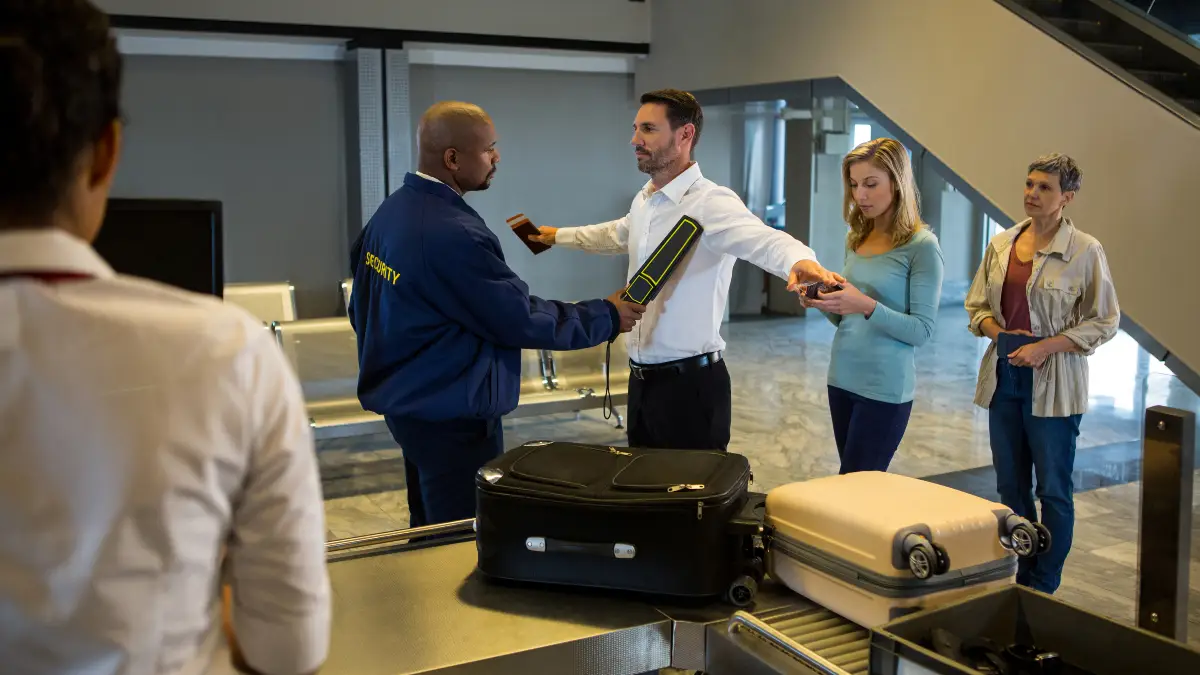A dream vacation shouldn’t end on a stranger’s doorstep, but that’s what happened to the Johnson family. They had saved for months, planning the perfect ten-year anniversary trip to a Caribbean beach house.
The online listing looked perfect. The pictures were stunning, the price was low, and the “owner” was friendly. He convinced them to send a $4,500 bank transfer to get a better deal. When they arrived with their kids and luggage, the real owners opened the door. The house was never for rent.
Their money was gone. Their dream trip was a disaster. They weren’t the only ones. In 2024, Americans lost a staggering $12.5 billion to travel scams just like this.
A Huge Problem Hiding in Plain Sight: The Data Behind the Lies

The pain that families like the Johnsons felt is just one story in a giant national crisis. The numbers, gathered by the top groups that protect consumers and enforce laws, show a scary picture. The fraud problem is not just big; it’s growing faster and getting more clever.
The Federal Trade Commission (FTC) says that Americans reported losing over $12.5 billion to fraud in 2024. That’s a huge 25% jump from the year before.
The FBI’s Internet Crime Complaint Center (IC3) reported an even bigger number of $16.6 billion in losses for the same time, a 33% increase. The groups count things differently, but they both agree on one thing: fraud is growing very quickly.
This jump in lost money isn’t because there are more scams. In fact, the FTC got 2.6 million fraud reports in 2024, which was about the same as in 2023.
The big change is that scammers are getting much better at their jobs. The share of fraud reports where someone lost money jumped from 27% in 2023 to 38% in 2024. This shows a scary trend: scammers are acting more like professionals.
They are getting much better at turning a scam attempt into a successful theft. They aren’t just trying to trick a lot of people; they are improving their methods to make sure more of their targets pay.
Table 1: The 2024 Fraud Problem by the Numbers
| Metric | 2024 Data | |
| Total Reported Losses (FTC) | $12.5 Billion (+25% YoY) | |
| Total Reported Losses (FBI IC3) | $16.6 Billion (+33% YoY) | |
| Victimization Rate Increase | 38% of reporters lost money (up from 27%) | |
| Riskiest Contact Method | Social Media ($1.9 Billion in losses) | |
| Deadliest Payment Method | Bank Transfer ($2.0 Billion in losses) | |
| Highest Median Loss (Age) | 80+ ($1,650 per incident) |
The Online Hunting Ground and the Payment Trap
Criminals today do most of their hunting online. Social media is no longer just a place to connect with friends. It has become a top spot for fraud, with $1.9 billion in reported losses in 2024.
A shocking 70% of people who were first contacted by a scammer on social media said they lost money. This makes it the most dangerous place for scams to start.
Scammers have a key strategy: they control how you pay. They guide their victims away from safe payment types and toward ones you can’t reverse. In 2024, bank transfers and direct payments caused the biggest total losses, adding up to $2 billion.
Cryptocurrency was next at $1.4 billion. People report scams involving credit cards a lot, but credit cards have fraud protection. Because of this, scammers try to stop you from using them for big payments.
When a seller demands a bank wire, Zelle payment, or crypto transfer, it’s a modern sign of a scam. Once you send the money that way, you almost never get it back.
Who Is at Risk? A Look at Different Age Groups
The numbers show two different groups of people are at risk. Younger adults, especially those 20-29 years old, get scammed more often. In 44% of the fraud reports they sent in, they said they lost money. That’s the highest rate for any age group.
They are likely targeted more because they spend more time online and on social media, where these scams are common.
On the other hand, older Americans get scammed less often, but when they do, the financial hit is much worse. Adults aged 70-79 who lost money reported a median loss of $1,000. For those 80 and older, that number was $1,650.
This is much higher than the median loss of $417 for victims in their 20s. Scammers target older adults because they know they often have more savings. They may also be easier to trick with scams that use authority figures or loneliness.
For many, losing their retirement savings is a terrible blow they can’t recover from. It can cause family problems and force them to rely on public help instead of the money they worked for their whole lives.
How the “Free” Luxury Cruise Scam Works

One of the oldest and trickiest travel scams is the promise of a “free” luxury cruise. You might get an unsolicited postcard, a fancy mailer, or see a pop-up ad. It often has the logos of big names like Southwest, Hilton, or Marriott to look real.
The offer is very tempting: a free cruise for two to a beautiful place. All you have to do is call a number to claim your prize. This is the bait. It’s the first step in a clever mind game.
The Hook and The Trap
When you call the number, you don’t reach a cruise line. You reach a call center for a marketing company. They have a smooth and professional script.
The agent tells you that you “won” and schedules you for a required 90-minute “travel exhibit” or “seminar” to get your prize vouchers. They won’t tell you what the meeting is really about. They often say it is not a timeshare sales pitch.
This meeting is the main part of the scam. It’s held in a hotel conference room. The room is set up to feel like you’re on vacation, which makes you lower your guard. Then, a long, high-pressure sales pitch begins. It’s designed to make you give in.
Salespeople work in teams and try to wear you out by making the meeting last for hours. They create a strong feeling that you must act now with a “today only” offer. This is a big discount on a vacation club or timeshare membership that they say will be gone if you leave the room.
This trick is meant to stop you from thinking clearly or doing your own research. The whole thing plays on how our minds work. The “free” cruise makes you feel like you owe them something, so you listen.
The hours you spend in the meeting make you feel like you’ve already invested time, so you don’t want to leave with nothing.
The Catch: What “Free” Really Costs
Some people are able to say no to the vacation club membership, which can cost from $3,000 to $10,000 for access to a simple booking website.
For them, the “free” cruise prize shows its real cost. To use the voucher, winners have to pay a list of fees upfront. These include port fees, government taxes, processing fees, and required daily tips. These can add up to hundreds of dollars for each person.
Also, the “free” cruise is usually for the worst inside cabin during the off-season. The company will push hard for the “winner” to pay for expensive upgrades to a better room or a more popular travel date.
In the end, the “free” vacation is an expensive trick. It’s a way to get leads for a high-pressure sales team that makes money whether you buy the big package or just pay the fees for a prize that was never really free.
How the Fake Vacation Rental Scam Works

The “free” cruise scam happens in person, but the fake vacation rental scam is different. It lives online, especially on social media sites where there aren’t many rules. It’s a very common type of travel fraud today because it works so well and causes so much damage.
The Hunting Ground: Why Scammers Love Facebook
Facebook is the main place for rental scams. A big 2024 survey by Rently found a shocking fact: 88% of rental scam victims saw the fake listing on Facebook. Another 12% found it on Craigslist.
Scammers love Facebook because it has so many users, very little security for private listings, and a false sense of community trust. They use the site’s features against people, turning a place for social connection into a tool for financial crime.
This problem has damaged people’s trust. Now, 40% of renters blame the rental websites for not protecting them.
The Scammer’s Plan
The scam is planned out and works very well. Scammers follow a set plan to attract, isolate, and steal from their targets.
The Listing:
They either “hijack” a real rental by copying its photos and details from sites like Airbnb or VRBO and posting them for a much lower price, or they make up a listing for a property that doesn’t exist or isn’t for rent.
The bait is a mix of a great location (which attracts 57% of victims), a price below market value (55%), and being available right away (52%).
This works especially well in popular travel spots where cheap options are hard to find. It preys on a family’s need to find a good place for their vacation.
The Isolation:
The scammer’s first and most important step is to get you off the website where you saw the listing. They will ask to move the chat to WhatsApp, text, or personal email. They’ll make an excuse, like avoiding site fees or talking more directly.
This takes the conversation away from any security checks and stops the site from flagging strange activity.
The Pressure:
Once you are talking privately, the scammer creates a lot of pressure. They will say that other families are interested and that you must decide and pay immediately to “secure” the property.
The Payment Trap:
The last step is to demand payment in a way that gives you no protection. They will say no to credit cards or payments through the site’s secure system.
Instead, they will insist on Zelle, Venmo (using the “Friends and Family” option, which has no fraud protection), a direct bank wire, or even cryptocurrency. They know that once you send money this way, it’s gone for good.
The financial and emotional results are terrible. Before they even know it’s a scam, 70% of victims have paid a security deposit, and half have paid the first month’s rent. More than 62% of victims lose over $500, and some lose more than $5,000.
One victim told the BBB Scam Tracker they lost $11,348 sent through Zelle for a fake Airbnb booking. That’s a huge amount of money that just disappeared. For these families, the scam ends with a horrible moment.
They arrive at their destination only to find the vacation home they paid for doesn’t exist. They are left stranded, out thousands of dollars, and with their vacation ruined before it started.
The 2025 Traveler’s Shield: A Guide to Staying Safe

Travel scammers use clever and new tricks, but they follow predictable patterns. They also take advantage of common human feelings.
If you learn these patterns and get in the habit of checking everything, you can build a strong defense to protect your money and your family. This guide gives you clear, simple rules for booking travel safely in 2025.
1. If It Seems Too Good To Be True, It Is
This old advice is still the best way to avoid fraud. Scammers attract victims by promising luxury for a very low price.
A beach house listed for half the price of others nearby or a “free” cruise that promises thousands of dollars in value are big red flags. Real businesses have to make money. Deals that seem unbelievable are almost always a setup for a scam.
2. Check the Seller, Not Just the Trip
Being excited about a trip can make you miss important details. You need to check the company or person selling the vacation just as carefully as you check the vacation itself.
For Vacation Rentals:
Be a digital detective. Search online for the property’s address. If you see it in other listings with a different owner’s name or contact info, it’s a stolen listing. Use Google’s reverse image search on the property photos.
This will show you if they were taken from another website. Search for the owner’s name and the rental company’s name online. Add words like “scam,” “complaint,” or “review” to find any bad history.
If the property is in a resort or condo building, call the front desk. Ask them to confirm the owner’s name and that the unit is really for rent.
For Travel Companies and Deals:
Check every offer yourself. If you get a postcard about a cruise, don’t call the number on it. Go to the official website of the cruise line it mentions (like Carnival or Royal Caribbean).
Call their official customer service number and ask if the deal is real. Check the business’s page on the Better Business Bureau website.
3. Stay on the Platform
When you book on big sites like Airbnb, VRBO, or others, their built-in message and payment systems are your best protection. If a host or agent asks you to switch the chat to a personal email, text, or WhatsApp, it’s a huge red flag.
It’s also against the site’s rules. In the same way, if they ask you to pay outside of the site’s secure payment system—even if they offer a discount—they are trying to take away all of your protections. You should say no right away.
4. Your Credit Card Is Your Best Protection
How you choose to pay is often the last line of defense. It can be the difference between a small problem and a huge financial loss.
Federal law gives you strong fraud protection when you use a credit card. It lets you challenge charges that are fake or that you didn’t approve. In most cases, you can get your money back.
Scammers know this. That’s why they will push you to pay in ways that are like sending cash: bank wires, Zelle, Venmo, Cash App, gift cards, or cryptocurrency. These methods are made for instant payments that can’t be taken back.
They are meant for people you trust. Once you send the money, it’s almost impossible to get it back. So, the most important rule is this: Always pay with a credit card. If a seller refuses to take it, walk away. It is a scam.
5. Don’t Fall for High-Pressure Sales
Scammers create a false sense of urgency to make you decide quickly and poorly. They say things like “this is the last one available,” “the price goes up tomorrow,” or “I have another family ready to book right now”.
This is a mind game to make you panic. It stops you from doing the research these rules tell you to do. A real business with a good product will give you time to think about your purchase. Any deal that needs an immediate, non-refundable payment is not a deal you should take.
Table 2: The Travel Scam Red Flag Checklist
| Red Flag | The Risk | Your Counter-Move |
| “You’ve Won!” Message You Didn’t Expect | This is bait for a high-pressure sales pitch or a scam with hidden fees. | Delete it. You can’t win a contest you didn’t enter. |
| Price is Much Lower Than Others | The property, ticket, or deal is probably fake or not what it seems. | Research and compare prices for similar, real offers in the same area. |
| Seller Wants to Talk or Get Paid Off-Platform | You will lose all website protections, and the seller is hiding from the rules. | Say no. Only use the platform’s secure message and payment systems. |
| Seller Demands Payment by Wire, Zelle, Crypto, or Gift Card | Your money will be gone for good once sent. This is the #1 sign of a scam. | Insist on paying with a credit card. If the seller says no, end the deal. |
| High Pressure to Book or Pay Right Now | The scammer is trying to stop you from researching and finding out it’s a fraud. | Stop and take a break. A real offer will still be there after you’ve had time to think. |
| Vague Details About the Property or Company | The company or listing is likely fake if they can’t give you specific, checkable information. | Ask for a specific street address or company number, and then check it yourself. |
| Bad Grammar or Unprofessional Messages | This is often a sign of a scam, especially one from another country. | Trust your gut. Stop talking to anyone who seems unprofessional. |
What to Do If You Get Scammed: A Step-by-Step Guide

Finding out you’ve been scammed is a terrible feeling. It often brings panic, anger, and shame. It’s hard to get your money back from some payment methods—one report found only 4% of scam victims ever get their money back—but it’s very important to act quickly and decisively.
These steps can help reduce the damage and are needed to report the crime to the police.
1. Deal With the Payment (Act Within Minutes or Hours)
What you do first depends on how you paid. You must act fast.
- If You Paid With a Credit or Debit Card: Call the number on the back of your card right away. Ask for the fraud department. Report the charge as fraud and ask for a “chargeback.” The bank will investigate, and you have a good chance of getting your money back.
- If You Sent a Bank or Wire Transfer: Call your bank’s fraud department immediately. If the transfer isn’t complete, they might be able to stop it. If you used a service like Western Union or MoneyGram, call their fraud hotline. Ask them to reverse the transfer if they can.
- If You Used a P2P App (Zelle, Venmo, Cash App): Report the scam to the app’s customer service and to your bank. These payments are instant and very hard to reverse, but reporting the fake account is still important.
- If You Paid With Cryptocurrency or Gift Cards: These payment types are almost impossible to trace or reverse. The money is probably gone. But you should still contact the gift card company (like Visa or Apple) or the crypto exchange to report the scam.
2. File Official Reports (Act Within Days)
Reporting the crime is important, even if you don’t think you’ll get your money back. Your report gives police important information to help them track down and stop criminal groups. It also helps warn other people.
- Federal Trade Commission (FTC): This is the most important report to file. Go to ReportFraud.ftc.gov and give as much detail as you can about the scam. The FTC uses this information to see trends, build legal cases against scammers, and share info with police across the country.
- FBI’s Internet Crime Complaint Center (IC3): For any scam that used the internet, file a complaint at ic3.gov. This is where the FBI collects information on cybercrime.
- Better Business Bureau (BBB): File a report on the BBB Scam Tracker. This creates a public report that can quickly warn others who might be looking for information on the same fake company or person.
- Local Police: File a report with your local police department. They might not be able to do much, but a police report number is an official record of the crime. Your bank or insurance company might need it.
Step 3: Protect Your Identity and Accounts
If you gave the scammer any personal information, you need to act to stop identity theft.
- If you gave a scammer your Social Security number, username, or passwords, go to the FTC’s IdentityTheft.gov website. It gives you a personal recovery plan, including how to put a fraud alert on your credit files.
- Change the passwords for any accounts that were affected right away. If you use the same password on other sites, change those too. Use two-factor authentication whenever you can for extra security.
Step 4: Handle the Emotional Stress
Losing money is only part of the problem. People who are scammed often feel very angry (60% of victims), lose their trust in others (54%), and feel anxious, stressed, or hurt (53%).
It’s important to remember that it’s not your fault. These scams are run by smart, professional criminals who are experts at tricking people. Talking to family, friends, or a therapist can be a big part of feeling better.
How the Government and Travel Experts Are Fighting Back

This growing travel scam problem has gotten people’s attention. Government groups and real travel companies are working to fight this danger. They offer ways to get help and are creating new rules to help people tell the difference between real professionals and criminals.
Government Action and Help for Consumers
It can be a slow process, but government groups do take action against scam operations. The Federal Trade Commission investigates and takes legal action against travel scams.
In one big case against a timeshare resale scam, the FTC’s work led to over 8,000 refund checks being mailed out. The total was almost $2.7 million for the people who were scammed. Cases like this show why it’s so important to report every scam.
These reports give the government the information it needs to take action, which can eventually lead to getting money back for victims.
An Industry Solution: The Certified Professional
The real travel industry knows that scams are a threat to the trust it is built on. To fight this, the American Society of Travel Advisors (ASTA), the world’s top group for travel professionals, has taken steps to make the industry more professional.
They want to give people a sure way to find a travel advisor they can trust.
The main part of this effort is the ASTA Verified Travel Advisor (VTA) certification program.31 This isn’t just a membership; it’s a serious professional qualification. To become a VTA, an advisor has to meet tough requirements.
They need at least two years of experience with yearly sales of $500,000 or more, or five years of experience with sales of $250,000 for five years in a row.
They also have to take classes on laws and ASTA’s Code of Ethics. They must continue their education to keep their certification.
The program works. ASTA’s President and CEO, Zane Kerby, shared a powerful fact: “…since 2017 when we launched the ASTA Verified Travel Advisor Certification, we’ve never fielded a single complaint against an ASTA Verified Travel Advisor”.
This amazing record makes the VTA certification a strong sign of approval for people trying to book travel in a risky market. To help people find these professionals, ASTA started VeriVacation.com.
It’s a new website made just to connect travelers with this special group of checked and approved advisors.


